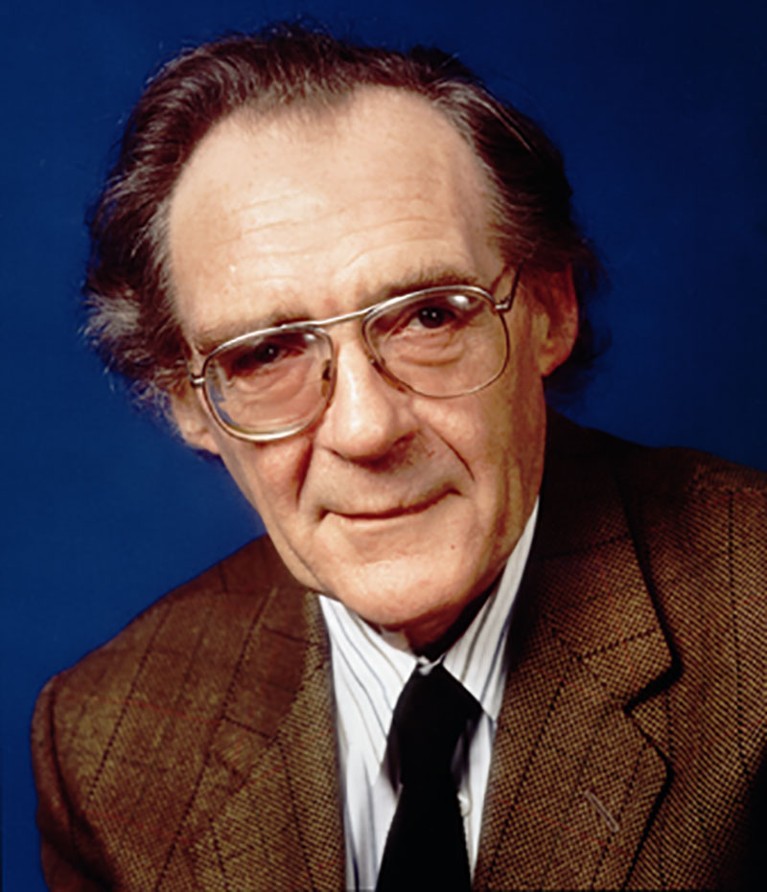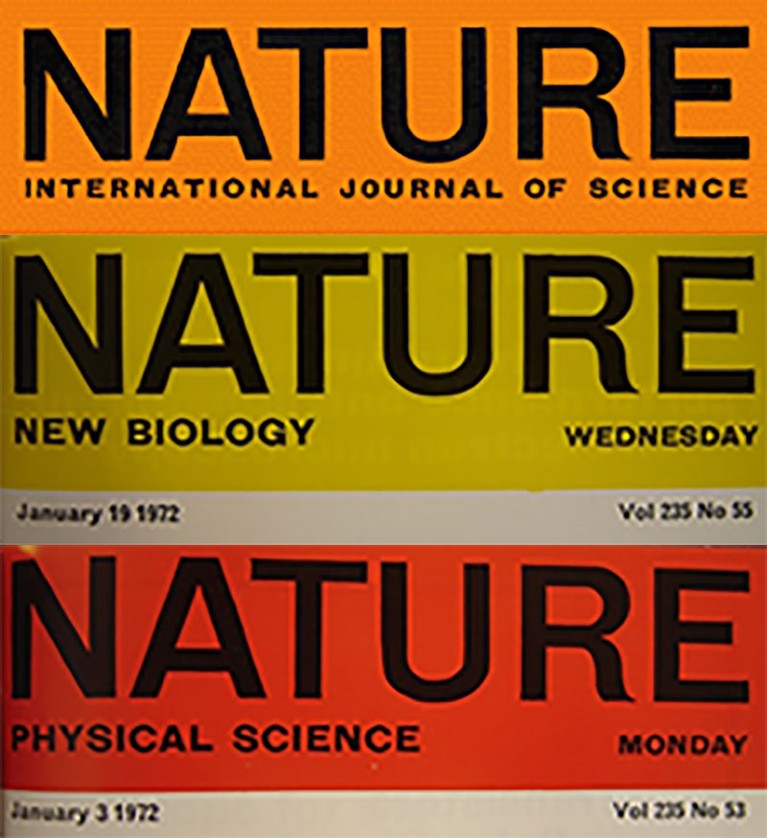
John Maddox brought an old-fashioned Nature into the modern age from the mid-1960s.
A newspaper man of an earlier era described an editor as “a person who knows precisely what he wants — but isn’t quite sure”. John Maddox, the fourth and sixth Editor of Nature, thereby both preceding and succeeding Dai Davies, was never prey to such debility. His impact on the journal from the moment of his arrival in 1966 was more invigorating and far-reaching than anything that had happened to it since the time of its founding Editor, Norman Lockyer. John Maddox occupied the editorial chair for 22 years in all (1966–73, 1980–95).
John Maddox had been both an academic — a lecturer in theoretical physics at the University of Manchester — and a journalist. As the first science correspondent of what was then the Manchester Guardian, he had printers’ ink in his bloodstream, and one of his first objectives was to infuse a little of this journalistic urgency into Nature. His wish, he said, was that every scientist would pad to the door in his carpet slippers on Thursday morning to snatch the new issue from the letter-box. In this he echoed H. G. Wells’s assertion about Nature some 40 years earlier that “no English-speaking scientist could go for a week without reading it”.
In truth, Maddox found the journal in a sadly reduced state on his arrival. Under the stewardship of L. J. F. (Jack to his intimates) Brimble, a certain stasis had set in. True, there had been some notable (always very brief) communications, most memorably perhaps that by Watson and Crick on the structure of DNA, but most contributions were pedestrian; ‘News and Views’ items were seldom about scientific advances, more often resembling a Court Circular in marking events such as the retirement of a civil servant or institute director, or the landmark birthday of a scientific notable.
Maddox lost no time in tearing down the journal’s fustian image. One of his first acts was to do away with the stately style of communication with authors and referees — the “Editors of Nature” would no longer “present their compliments, and beg to inform …,” or “trust that the enclosed manuscript would be of interest” to the recipient (their discreet way of soliciting an opinion of the paper’s worth). There would be no more editorial ‘we’ (which, Mark Twain opined, only presidents, editors and people with tapeworms had the right to use).
Maddox recruited a staff of lively young people, many of whom later achieved high distinction. One of them, Nicholas Wade, who was to become science editor of The New York Times, has related that no sooner had he arrived, with only a degree in classics to commend him, than he was invited to write a leader on the world’s first heart transplant. His protest that he knew nothing of such matters was met by the reply that there was no better qualification for writing an editorial.
The News and Views section was relaunched with regular commentaries on current developments in research. The Times undertook to publish daily an item of scientific news, provided by Nature staff. Maddox’s innumerable contacts from his years as a science journalist enabled him to solicit papers from leading laboratories. These were sometimes published without the tedious formality of review — a sure way at the time of securing a good crop of the very best, and stealing a march on the competition.
Meanwhile, a huge backlog of unpublished manuscripts from the previous régime was steadily reduced (according to Maddox, these presented the outline of a histogram on the windowsill on which they were stacked in monthly piles). At the same time, an expeditious reviewing system was set up, supplanting Brimble’s preferred custom of cramming manuscripts into his coat pockets and distributing them among the scientific mandarins over lunch at the Athenaeum — the club for the great and the good.
A style manual was compiled, and manuscripts were extensively, often savagely, copy-edited. This unquestionably improved cogency and readability. The results were welcomed by many, but by no means all authors. And indeed the practice had its drawbacks, especially when, at one period, there were problems with the printers, and proofs did not always reach the authors in time. On one celebrated occasion, a copy-editor provoked displeasure when, following as he thought the rule that authors must not refer to themselves in the third person, he changed a sentence in a book review that read “The author is of course the world’s leading authority on the genetics of …” to “I am of course …”
Gradually, the character of the papers and letters in Nature changed. It had been the custom of many contributors to treat the journal as a convenient vehicle for the preliminary announcement of a result, the real meat to follow in a weightier organ. But in time the changes that John Maddox had wrought transformed Nature into the very foremost international showcase for new discoveries. A paper in Nature could change the course of a career, and to say that there were those who would kill to achieve that consummation is not altogether an overstatement, for on at least one occasion Dai Davies received a death threat from an enraged supplicant. During John Maddox’s first term, a repeatedly rejected physicist threatened to immolate himself on the steps of the Nature office. (He forbore in the end to do so, having hit on the ruse of publishing his paper as an advertisement.)

Under Maddox the journal split into three entities — Nature, Nature New Biology and Nature Physical Science.
As the submissions flooded in, Maddox conceived the plan to launch a pair of satellite journals, called Nature New Biology and Nature Physical Science — perhaps in pursuit of a vision of a daily Nature. It was a prescient scheme, but the principle of making those and the Thursday Nature affordable to individual subscribers proved too ambitious, and when Maddox left the first time, the satellites were killed off. This may have been an ill-considered decision, for they prefigured a felicitous surge several years later of more specialized sister journals.
A feature of John Maddox’s editorship was his relish for the journalistic coup. The most famous of these was his decision to publish the paper by Jacques Benveniste on the biological effect of a protein diluted beyond the Avogadro limit (which could have left nothing more behind than the memory of its presence). It appeared with a commentary by Walter Stewart, an aficionado of scientific fraud, in which the data were demolished, following his visit to Benveniste’s laboratory with the Editor and a famous magician. Opinion was divided on whether such shenanigans brought the journal into disrepute or merely added to the gaiety of nations. In France it was widely (and quite unjustly) perceived as an underhand trick by perfidious Albion to make French science look foolish.
Dai Davies brought a more academic style to the Nature offices in Little Essex Street. Yet, in the six-year interval between Maddox’s two incarnations, he maintained the momentum of the journal’s progress. Davies made Nature covers more eye-catching, introduced sketch cartoons and a popular columnist or two, and published some entertaining papers — not least on controversial topics such as the Loch Ness monster and a laboratory test of Uri Geller’s self-proclaimed telepathic powers. He retained Maddox’s emphasis on news and wrote some trenchant leaders, particularly on nuclear issues. Davies strengthened the editorial teams and gave them greater independence, and enlarged the pool of contributors to News and Views. John Maddox found the journal in a healthy state on his return in 1980.
As Nature grew more influential, more pages were added, and the rejection rate rose ever higher. It has been said that it is the business of an editor to separate the wheat from the chaff, and to see that the chaff is printed. But in Nature there was, and is, little chaff, and the problem rather was that so much good wheat had to be rejected purely for want of space. And so the sister journals began to see the light. By the time John Maddox relinquished the chair for the second time, there were three, and their success, based on the now-irresistible Nature name, was instant.
The scope of the institution’s activities had been broadened in other ways — in international conferences, links with newspapers and press releases for it had become the voice of science worldwide. It was an effulgent and thriving concern that Maddox bequeathed to his successor; in 1995 he was knighted for his services to science.

 Lockyer’s columns of controversy in Nature
Lockyer’s columns of controversy in Nature
 Nature under Hitler
Nature under Hitler
 Mankind’s place in Nature: the Gale–Brimble years
Mankind’s place in Nature: the Gale–Brimble years
 Nature during the cold war
Nature during the cold war
 The demise of the lone author
The demise of the lone author


